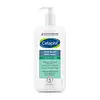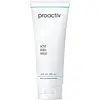What's inside
What's inside
 Key Ingredients
Key Ingredients

 Benefits
Benefits

 Concerns
Concerns

 Ingredients Side-by-side
Ingredients Side-by-side

Salicylic Acid 2%
MaskingBenzyl Alcohol
PerfumingButyrospermum Parkii Butter
Skin ConditioningCocamidopropyl Betaine
CleansingGlycerin
HumectantGlycine Soja Oil
EmollientGuar Hydroxypropyltrimonium Chloride
Skin ConditioningHydrogenated Soybean Oil
EmollientHydroxypropyl Starch Phosphate
Lactic Acid
BufferingLauric Acid
CleansingPalmitic Acid
EmollientPhenoxyethanol
PreservativeSodium Benzoate
MaskingSodium Chloride
MaskingSodium Hydroxide
BufferingSodium Lauroyl Glycinate
CleansingSodium Lauroyl Isethionate
CleansingStearic Acid
CleansingTetrasodium EDTA
Water
Skin ConditioningSalicylic Acid 2%, Benzyl Alcohol, Butyrospermum Parkii Butter, Cocamidopropyl Betaine, Glycerin, Glycine Soja Oil, Guar Hydroxypropyltrimonium Chloride, Hydrogenated Soybean Oil, Hydroxypropyl Starch Phosphate, Lactic Acid, Lauric Acid, Palmitic Acid, Phenoxyethanol, Sodium Benzoate, Sodium Chloride, Sodium Hydroxide, Sodium Lauroyl Glycinate, Sodium Lauroyl Isethionate, Stearic Acid, Tetrasodium EDTA, Water
Salicylic Acid 2%
MaskingAcrylates Copolymer
Aloe Barbadensis Leaf Extract
EmollientButylene Glycol
HumectantButyrospermum Parkii Butter
Skin ConditioningChromium Hydroxide Green
Citric Acid
BufferingCocamidopropyl Betaine
CleansingCoco-Betaine
CleansingCoconut Acid
CleansingDisodium EDTA
Parfum
MaskingGlycerin
HumectantGlycol Distearate
EmollientGlycolic Acid
BufferingHydroxypropyl Methylcellulose
Emulsion StabilisingLaureth-4
EmulsifyingLauroyl/Myristoyl Methyl Glucamide
EmollientMannitol
HumectantMicrocrystalline Cellulose
AbsorbentOlive Oil PEG-8 Esters
EmollientPolyquaternium-39
Prunus Amygdalus Dulcis Oil
Skin ConditioningSodium C14-16 Olefin Sulfonate
CleansingSodium Chloride
MaskingSodium Hydroxide
BufferingSynthetic Wax
AbrasiveTheobroma Cacao Seed Butter
EmollientTocopheryl Acetate
AntioxidantWater
Skin ConditioningSalicylic Acid 2%, Acrylates Copolymer, Aloe Barbadensis Leaf Extract, Butylene Glycol, Butyrospermum Parkii Butter, Chromium Hydroxide Green, Citric Acid, Cocamidopropyl Betaine, Coco-Betaine, Coconut Acid, Disodium EDTA, Parfum, Glycerin, Glycol Distearate, Glycolic Acid, Hydroxypropyl Methylcellulose, Laureth-4, Lauroyl/Myristoyl Methyl Glucamide, Mannitol, Microcrystalline Cellulose, Olive Oil PEG-8 Esters, Polyquaternium-39, Prunus Amygdalus Dulcis Oil, Sodium C14-16 Olefin Sulfonate, Sodium Chloride, Sodium Hydroxide, Synthetic Wax, Theobroma Cacao Seed Butter, Tocopheryl Acetate, Water
 Reviews
Reviews

Ingredients Explained
These ingredients are found in both products.
Ingredients higher up in an ingredient list are typically present in a larger amount.
This ingredient is also known as shea butter. It is an effective skin hydrator and emollient.
Emollients help soothe and soften your skin. It does this by creating a protective film on your skin. This barrier helps trap moisture and keeps your skin hydrated. Emollients may be effective at treating dry or itchy skin.
Shea butter is rich in antioxidants. Antioxidants help fight free-radicals, or molecules that may harm the body. It is also full of fatty acids including stearic acid and linoleic acid. These acids help replenish the skin and keep skin moisturized.
While Shea Butter has an SPF rating of about 3-4, it is not a sunscreen replacement.
Shea butter may not be fungal acne safe. We recommend speaking with a professional if you have any concerns.
Learn more about Butyrospermum Parkii ButterCocamidopropyl Betaine is a fatty acid created by mixing similar compounds in coconut oil and dimethylaminopropylamine, a compound with two amino groups.
This ingredient is a surfactant and cleanser. It helps gather the dirt, pollutants, and other impurities in your skin to be washed away. It also helps thicken a product and make the texture more creamy.
Being created from coconut oil means Cocamidopropyl Betaine is hydrating for the skin.
While Cocamidopropyl Betaine was believed to be an allergen, a study from 2012 disproved this. It found two compounds in unpure Cocamidopropyl Betaine to be the irritants: aminoamide and 3-dimethylaminopropylamine. High-grade and pure Cocamidopropyl Betaine did not induce allergic reactions during this study.
Learn more about Cocamidopropyl BetaineGlycerin is already naturally found in your skin. It helps moisturize and protect your skin.
A study from 2016 found glycerin to be more effective as a humectant than AHAs and hyaluronic acid.
As a humectant, it helps the skin stay hydrated by pulling moisture to your skin. The low molecular weight of glycerin allows it to pull moisture into the deeper layers of your skin.
Hydrated skin improves your skin barrier; Your skin barrier helps protect against irritants and bacteria.
Glycerin has also been found to have antimicrobial and antiviral properties. Due to these properties, glycerin is often used in wound and burn treatments.
In cosmetics, glycerin is usually derived from plants such as soybean or palm. However, it can also be sourced from animals, such as tallow or animal fat.
This ingredient is organic, colorless, odorless, and non-toxic.
Glycerin is the name for this ingredient in American English. British English uses Glycerol/Glycerine.
Learn more about GlycerinSalicylic Acid (also known as beta hydroxy acid or BHA) is a well-known ingredient for treating skin that struggles with acne and clogged pores. It exfoliates both the skin's surface and deep within the pores to help clear out buildup, control oil, and reduce inflammation.
Unlike AHAs (alpha hydroxy acids), salicylic acid is oil-soluble. This allows it to penetrate into pores which makes it especially effective for treating blackheads and preventing future breakouts.
Salicylic acid is also known for its soothing properties. It has a similar structure to aspirin and can calm inflamed or irritated skin, making it a good option for acne-prone skin that is also sensitive.
Concentrations of 0.5-2% are recognized by the U.S. FDA as an over-the-counter topical acne product.
It can cause irritation and/or dryness if one's skin already has a compromised moisture barrier, so it's best to focus on repairing that before introducing this ingredient into your routine.
While salicylic acid does not increase sun sensitivity, it’s still important to wear sunscreen daily to protect your skin.
If you are looking for the ingredient called BHA or Butylated Hydroxyanisole, click here.
Learn more about Salicylic AcidChances are, you eat sodium chloride every day. Sodium Chloride is also known as table salt.
This ingredient has many purposes in skincare: thickener, emulsifier, and exfoliator.
You'll most likely find this ingredient in cleansers where it is used to create a gel-like texture. As an emulsifier, it also prevents ingredients from separating.
There is much debate on whether this ingredient is comedogenic. The short answer - comedogenic ratings don't tell the whole story. Learn more about comegodenic ratings here.
The concensus about this ingredient causing acne seems to be divided. Research is needed to understand if this ingredient does cause acne.
Scrubs may use salt as the primary exfoliating ingredient.
Learn more about Sodium ChlorideSodium Hydroxide is also known as lye or caustic soda. It is used to adjust the pH of products; many ingredients require a specific pH to be effective.
In small amounts, sodium hydroxide is considered safe to use. However, large amounts may cause chemical burns due to its high alkaline.
Your skin has a natural pH and acid mantle. This acid mantle helps prevent harmful bacteria from breaking through. The acid mantle also helps keep your skin hydrated.
"Alkaline" refers to a high pH level. A low pH level would be considered acidic.
Learn more about Sodium HydroxideWater. It's the most common cosmetic ingredient of all. You'll usually see it at the top of ingredient lists, meaning that it makes up the largest part of the product.
So why is it so popular? Water most often acts as a solvent - this means that it helps dissolve other ingredients into the formulation.
You'll also recognize water as that liquid we all need to stay alive. If you see this, drink a glass of water. Stay hydrated!
Learn more about Water